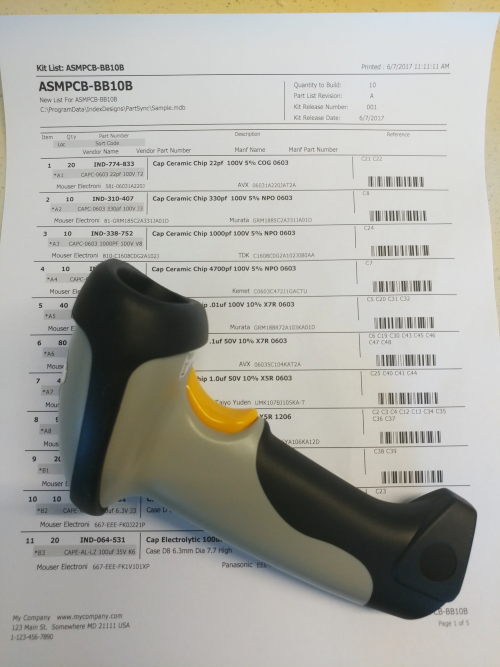
Plastics
Unique cut tape management system.
Small pill boxes for engineering parts.
Tray system holds 1000s of different parts in a small space.
Quickly access any part.
Buy Loose Stock Pill Boxes Here
Electronic circuits are constructed from a large number of different components. Most are very small and many lack any means of identification.
- Engineering Stock: Used by technical people to design, debug and rework electronic assemblies. Engineering stock consists of a large array of components in small quantities which can be quickly located and accessed.
- Reel & Cut Tape Stock: Reels of component tape are the most common packaging format. Large labels for reels and small labels for component tapes are provided.
Plastic trays and accessories are available to simplify the handling of engineering and cut tape stock. Small boxes hold any and all loose engineering stock. Our custom plastic reels hold strips of cut tape. These storage containers allow for easy finding of parts using labels with bar codes. Hundreds of different components are conveniently organized and arranged in a few feet of shelf space. Special coding on labels enables instant location.

BarCode Labels & Barcode Scanners
Both fully supported.
Makes it easy to find parts in your storage system.
Nice neat printout of all the parts you need.
Supports both wired and wireless barcode scanners.
Label all of your parts with easy-to-print labels and barcodes. Wired or wireless barcode scanners easily scan your labels and locate parts in your database.
The barcode on a package of parts destined for a kit must indicate not only the part number for the parts in the package but it must also identify the "Kit" where the parts will be placed. It could be the case that a received part package is to be used in two or more different kits. Many existing MRP systems use simple "Part Number" barcodes to identify a container, and users are left to figure out from purchase order notes how a physical package is to be handled. PartSync uses unique container key codes which can index into container routing controls. Identifying the actual part number and part description is then a trivial side task done in software.

Labels and Printers
Custom labels for each storage type.
All labels use unique barcode IDs.
Supports both Direct and Thermal Transfer printers.
PartSync will print on a large array of printers. Any Windows printer with the correct label sizes can be used. Existing drivers support low-cost Brother printers to larger more expensive Zebra printers. Create labels for every part that you have in stock. Labels easily go on reels, cut tape and on small engineering containers. Each label will have the generated part number from your database with all the information on what part is inside.
PartSync provides support for four label sizes:
- 2.25 x 0.75 inch Engineering Stock Labels
- 3.0 x 2.0 inch Reel and Shelf Labels
- 2.25 x 1.0 inch Cut Tape Labels
- 1.5 x 0.18 inch Tape Tag Labels

PartSync is a desktop database application used to manage electronic part data, Bill of Materials (BOM), component kits and vendor purchase lists. PartSync provides advanced features for labeling, material storage and barcoded labels. Search engines make finding parts and part information fast and easy. A datasheet librarian organizes component documents, and a PCB footprint library supports PCB design activities.
PartSync provides several features that MRP systems tend to ignore. These include various label styles, barcodes, shelving codes, search engines, a Datasheet Librarian and a CAD tool interface. PartSync can operate in a "disconnected mode" where database consistency is maintained through shared "repositories". This mode allows remotes users to work on projects while offline from remote database servers.
Disconnected Operation:
Most large MRP / ERP systems are client server in nature, where a database server (typically an SQL server) runs on a Windows Server or Linux machine. Workstations (the clients) connect via a local LAN, or perhaps using a VPN through the internet. The advantage of a client server system is this single server runs 24/7, is not used for running desktop apps and is powered through an Uninterruptable Power Supply (UPS). The same architecture applies to web-based SaaS, services except the server is remote. This is a very reliable architecture for database servers, though it does requires special hardware and software and it introduces a single point failure.
PartSync is completely different. The database engine is the JET/ACE system, which is now part of every Windows OS since Win XP. These database tools are very robust. Microsoft has used this engine to power the LDAP protocols (Windows login and Directory Access) since Win NT. Running a client machine on a UPS, or sharing the JET/ACE file (.mdb or.accdb) on a LAN file share provides the full client/server reliability at much lower complexity and cost. With each client fully self sufficient, there is no single point failure possible. Each client maintains a complete set of data backups which eliminates central server backup requirements.
Since the ACE/JET database tools are built into Windows, and since a single .mdb or .accdb file transports the entire database, remote users do not need to connect with a remote server when working with part data. PartSync includes support for synchronizing client data with remote "Repositories" which keeps all clients up to date.
CAD libraries can be greatly simplified. With three schematic symbols (Resistor, Cap and Polarized Cap) and a few PCB footprints (0603, 0805 and 1206) many tens of thousands of parts can be fully defined. Output from PartSync can be used to back-annotate schematics with PCB footprint data, keeping schematics simple and libraries tiny. Designers can now work in parallel remotely, as libraries are greatly simplified.
